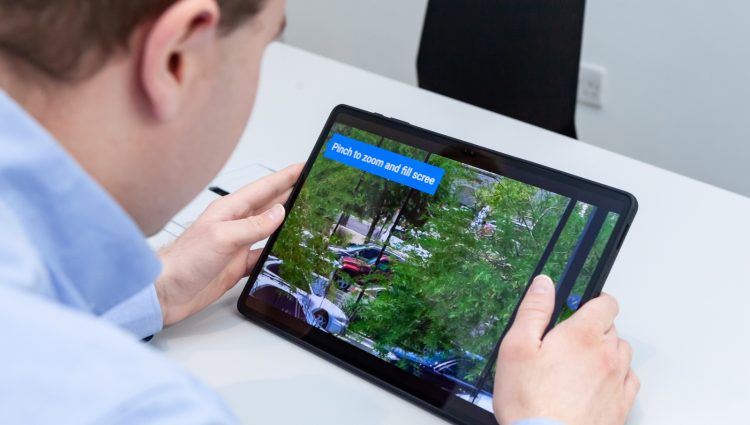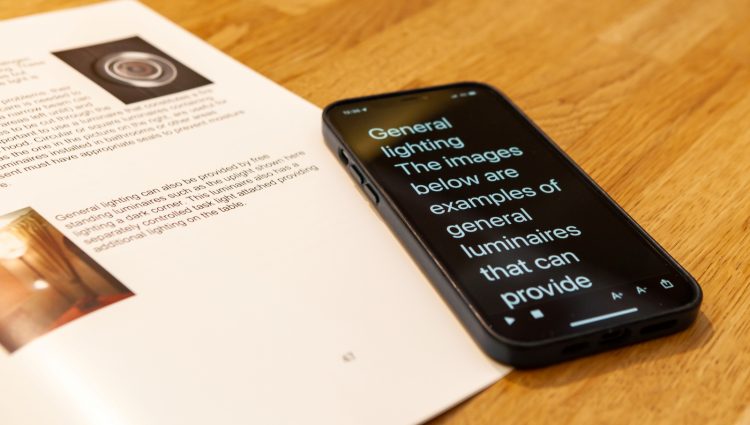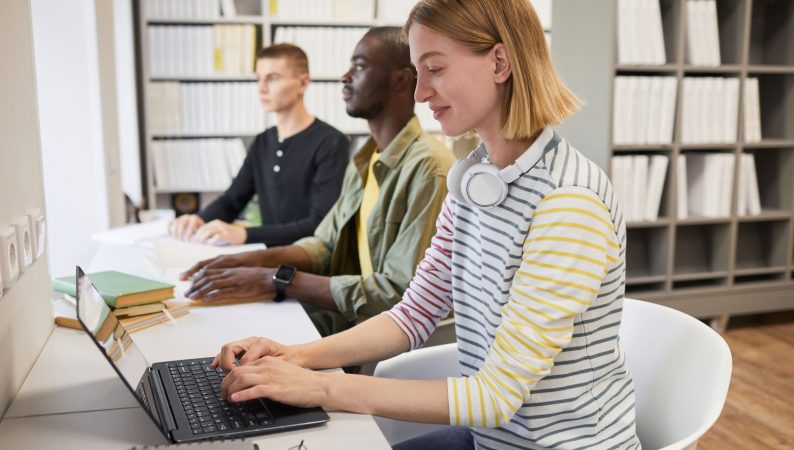Want to know one of the easiest ways to take your productivity to pro level? Learn how to touch type! As a blind or partially sighted student, knowing your way around a keyboard without needing to see the keys will massively speed up your use of the devices you work with in your education and beyond.
So, let’s dive into touch typing, how it can boost your productivity and how to get started with learning this impactful skill!
What is touch typing?
Touch typing is a method of typing on a keyboard using all of your fingers, where you memorise where each key is and which finger you use to press it. Once you have learnt where the keys are by touch, you no longer have to look down at the keyboard. This will remove any need for you to use your sight, freeing up your ability to type much faster!
The standard layout for UK keyboards is known as QWERTY. It is divided into three rows of letters, with the number row above. Touch typing involves settling your fingers on the middle row of letters, on what are known as the home keys. The left hand stays on the A, S, D and F keys and the right hand on the J, K, L and ‘;’ keys. Your fingers stay on these keys, and you only move one finger at a time to find others. The F and J keys both have small, raised lines or dots moulded on them so you can easily find the home keys by touch.
Why should I learn to touch type?
You may be used to tapping on a screen to enter text on your smartphone/tablet and are wondering why you would need to use a keyboard. Or you might have been told you should learn to touch type, but never saw the need to do it. Or perhaps you never got the hang of it. Maybe you can type on a keyboard using one or two fingers. So why would you need to touch type?
These methods all work fine up to a point. But as you start to progress through your education and career, those approaches will hold you back and be a major productivity drag. Once you get to writing longer documents like essays or dissertations, you’re going to want to be able to type as quickly and accurately as possible. This will most likely be on a computer, especially if you are in a school, college, university or workplace environment. So, knowing your way around a real keyboard will be an important skill.
Here are some of our favourite reasons why touch typing can be a game-changer:
- Speed and efficiency – it will unlock your ability to get more done, to a higher standard and in less time!
- Vision is not a factor – you’ll never have to look at the keys again, saving you time and eye strain.
- Independence – feel empowered to use your device at your top speed without having to rely on anyone else.
- Employability – many jobs require computer skills, so being able to touch type can help you in gaining employment. Touch typing is a skill that will be an advantage you have in your corner your whole life.
- You can show off – impress friends, teaching staff and potential employers with your speedy typing skills!
Top tip – touch typing makes using a screen reader easier!
If you’re a screen reader user, you don’t just use the letters on your keyboard for typing. You’ll also need to use them to perform keyboard shortcuts and navigate your computer. This makes effortlessly knowing the layout of your keyboard a massive productivity hack! It will come in handy for using keyboard shortcuts in other apps as well.
I know braille, do I need to touch type?
If you’re a confident and quick user of Braille input, you might be wondering why you would need to learn to touch type. There are digital options for Braille input, such as refreshable Braille displays with Braille keys. But touch typing is a universal skill, which will enable you to type on any computer you’re faced with. It’s absolutely worth learning to touch type, even if you prefer Braille input. If you don’t happen to have a device with Braille keys to hand, touch typing can be a handy fall-back.
Top tip – use a Bluetooth keyboard with your mobile devices to unlock your top speed
If you are using a smartphone/tablet in your studies, it’s definitely a good idea to pair your device with a Bluetooth keyboard, it will save you a ton of time and allow you to harness the power of touch typing and keyboard shortcuts. Find out more about Bluetooth keyboards on our Useful Accessible Accessories page!
How do I learn to touch type?
There are different tools out there to help you learn touch typing. But the most accessible we have found is a free online tool called Doorway Online. Doorway will take you from your first lesson, using the home keys right through to the most advanced level. You can customise the lessons to make them more accessible, with font size, contrast and speech output options.
Get started with Doorway here!
Other sites where you can learn to touch type include Typing Club, Touch Typing Study, and Rapid Typing. These are all free to use, and can even make learning touch typing fun by turning the lessons into games and challenges for you to complete!
Like developing any new skill, it can take time to learn to touch type. It might feel frustrating at first, but once you get good at it, you will find it hard to believe you managed without it. Not only will you have a valuable productivity superpower in your locker, but you’ll also be able to impress everyone with how fast you can type!
Top tip – practise like a pro
Touch typing is all about muscle memory, so the best way to teach your muscles is by practising little and often. A few minutes a day will go a lot further and produce a much quicker improvement than an hour once a week.
Get involved!
We want to hear your experiences of using technology in your education! Can you touch type? Are you going to start learning to? Are there any apps or tools you use in your studies you would like to tell other students about? Check out our Instagram, X or Facebook to get involved!
Need support with accessing your education?
Our Education Information Advice and Guidance Service is here for blind and partially sighted students aged 7+, their families and the professionals that support them. We provide expert information, advice and guidance supporting students to navigate primary, secondary school, college and university.
If you have any questions about accessing your education, please reach out to us by visiting our Education Information, Advice and Guidance Webpage.







